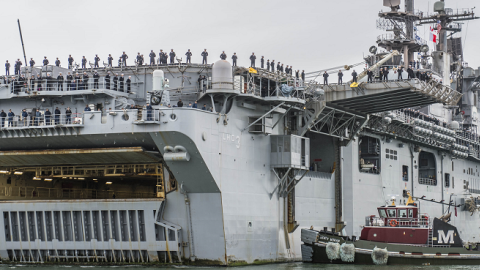Earlier this year, the CNO released his 2015-2019 Navigation Plan, a document that I wrote about elsewhere In that review, I wrote:
__"The Navy stands today at 290 ships in its “deployable battle force”. With these ships, it strains to fill two combat power hubs (Arabian Gulf/Indian Ocean and Western Pacific) and provide mission tailored forces wherever else they are needed. The plain truth is that even this number is insufficient, and the mechanism of necessity for mitigating this insufficiency remains extending deployment lengths. Late in the Cold War, the Navy arrived at a six month deployment standard, which it believed was essential to retaining the talent that had “voted with its feet” during the routine eight and nine month deployments of the Vietnam era. Yet just last week, the CARL VINSON Carrier Strike Group set out from the West Coast on its scheduled ten month deployment. This is not an aberration. Eight months has become the new goal, one that is regularly exceeded."__
There exists in the brain of a much better mathematician than I a formula to describe the relationship among the following variables (not inclusive): number of ships, operational availability, requirements for those ships, and deployment length. Generally speaking, in order to control deployment length--or as in this example, reduce it--one could increase the number of ships in the fleet, get more time deployed per hull (operational availability) by a number of different measures, or reduce requirements.
The six month standard adhered to during the late Cold War and after is now a thing of the past, a victim of too small a fleet spread across too large a number of requirements. Deployment length has been inching up for over a decade, tracking inversely with the size of the fleet, and the news is replete with stories like the one I cited above, in which the CARL VINSON Strike Group was deploying on a scheduled ten-month deployment.
Which brings us to yesterday's Navy Times story in which the CNO stated during an All Hands Call that lengthy eight-month deployments are no longer sustainable, and seven-month deployments are achievable, pointing to the recently announced Optimized Fleet Response Plan model which has already gotten off to a rough start
It occurs to me that somewhere between Fleet Forces Command and the CNO's Office, a spreadsheet and PowerPoint tandem exist that depicts a situation in which if all the cosmic tumblers clicked into place, this would be an achievable goal. Yet such a brief would be the only place in nature that such a plan would work--on paper. The assumptions that support such a lock-step view of the future are sure to vary, and some of the assumptions made from the beginning are subject to great scrutiny.
The first is the size of the fleet. It is virtually certain that the Navy's 30 Year Shipbuilding Plan and its goal of a 306 ship Navy underpins the OFRP, yet without a considerable increase in shipbuilding resources above historical allocations, the 306 ship Navy is unaffordable (as discussed in the article of mine linked to above). Not to put too fine a point on it, but the current 290 ship Navy is unaffordable without an increase in shipbuilding resources. Put another way, without a change in resources, the fleet will get smaller than it is today, seriously jeopardizing the CNO's goal.
The second is operational availability. While the Navy is doing visionary things with forward stationing LCS in Singapore, DDG's in Rota, and eventually Amphibs in Australia (each of which increases THOSE HULLS' operational availability) the price to do so includes significant hits to the readiness of non-deployed units as a result of deferred and canceled maintenance. In doing so, the aggregate fleet operational availability likely remains flat at best and more likely declines. Put another way, not only is the fleet getting smaller, it is becoming less available, as forward deployed readiness will increasingly come at the cost of non-deployed and surge readiness.
The third assumption worth scrutiny is that the demand for naval forces remains stable. While I have no insight into whether this assumption was made, it occurs to me to be logical. Until it isn't anymore. Our existing force structure inadequately services the existing demand for naval forces, and as that fleet declines in numbers, it will be harder pressed to meet those demands. Yet China is rising, Iran is flexing, and the Mediterranean is roiling. It is not difficult to conjure up a situation in which demand for naval forces increases at the very time budgetary pressures create fewer resources to meet it.
Unfortunately, the prospects for success in meeting the CNO's goal are dim, but more is at stake than just an overextended Service Chief. The Navy is fraying, and it is no longer simply around the edges. It is too small to meet the current demand from its two-hub construct, even as that two hub construct reveals itself to be half-again too small to adequately protect and sustain American interests. The Navy must AT A MINIMUM be properly resourced to meet its current force structure's needs while it constructs and argues the case to grow to meet easily foreseeable increases in demand in the future.

















